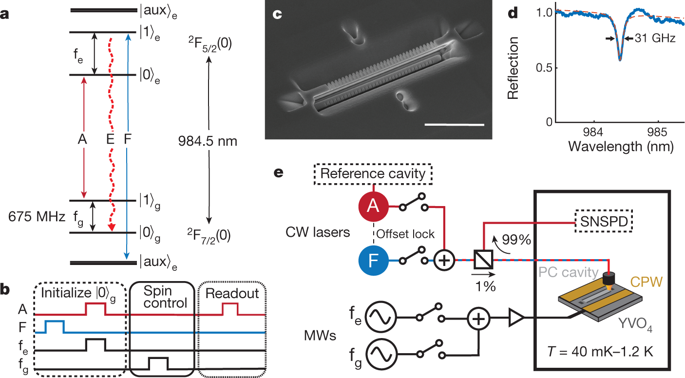Nature ( IF 50.5 ) Pub Date : 2020-03-30 , DOI: 10.1038/s41586-020-2160-9 Jonathan M Kindem 1, 2, 3, 4, 5, 6 , Andrei Ruskuc 1, 2, 3 , John G Bartholomew 1, 2, 3, 7 , Jake Rochman 1, 2, 3 , Yan Qi Huan 1, 2, 3, 8 , Andrei Faraon 1, 2, 3

|
Distributing entanglement over long distances using optical networks is an intriguing macroscopic quantum phenomenon with applications in quantum systems for advanced computing and secure communication1,2. Building quantum networks requires scalable quantum light–matter interfaces1 based on atoms3, ions4 or other optically addressable qubits. Solid-state emitters5, such as quantum dots and defects in diamond or silicon carbide6,7,8,9,10, have emerged as promising candidates for such interfaces. So far, it has not been possible to scale up these systems, motivating the development of alternative platforms. A central challenge is identifying emitters that exhibit coherent optical and spin transitions while coupled to photonic cavities that enhance the light–matter interaction and channel emission into optical fibres. Rare-earth ions in crystals are known to have highly coherent 4f–4f optical and spin transitions suited to quantum storage and transduction11,12,13,14,15, but only recently have single rare-earth ions been isolated16,17 and coupled to nanocavities18,19. The crucial next steps towards using single rare-earth ions for quantum networks are realizing long spin coherence and single-shot readout in photonic resonators. Here we demonstrate spin initialization, coherent optical and spin manipulation, and high-fidelity single-shot optical readout of the hyperfine spin state of single 171Yb3+ ions coupled to a nanophotonic cavity fabricated in an yttrium orthovanadate host crystal. These ions have optical and spin transitions that are first-order insensitive to magnetic field fluctuations, enabling optical linewidths of less than one megahertz and spin coherence times exceeding thirty milliseconds for cavity-coupled ions, even at temperatures greater than one kelvin. The cavity-enhanced optical emission rate facilitates efficient spin initialization and single-shot readout with conditional fidelity greater than 95 per cent. These results showcase a solid-state platform based on single coherent rare-earth ions for the future quantum internet.
中文翻译:

嵌入纳米光子腔中的离子的控制和单次读出
使用光网络长距离分布纠缠是一种有趣的宏观量子现象,在量子系统中用于高级计算和安全通信1,2。构建量子网络需要基于原子3、离子4或其他光学可寻址量子位的可扩展量子光-物质接口1。固态发射器5,例如金刚石或碳化硅中的量子点和缺陷6,7,8,9,10,已成为此类接口的有希望的候选者。到目前为止,还无法扩大这些系统的规模,从而推动了替代平台的开发。一个核心挑战是识别发射器,这些发射器表现出相干的光学和自旋跃迁,同时耦合到光子腔,从而增强光与物质的相互作用并将发射通道发射到光纤中。已知晶体中的稀土离子具有高度相干的 4 f –4 f光学和自旋跃迁,适用于量子存储和转导11,12,13,14,15,但直到最近才分离出单个稀土离子16, 17并耦合到纳米腔18,19. 将单个稀土离子用于量子网络的关键下一步是在光子谐振器中实现长自旋相干性和单次读出。在这里,我们展示了自旋初始化、相干光学和自旋操纵,以及单个171 Yb 3+的超精细自旋状态的高保真单次光学读数离子耦合到在原钒酸钇主体晶体中制造的纳米光子腔。这些离子具有对磁场波动不敏感的一阶光学和自旋跃迁,即使在高于 1 开尔文的温度下,腔耦合离子的光学线宽也小于 1 兆赫,自旋相干时间超过 30 毫秒。腔增强的光学发射率有助于有效的自旋初始化和单次读出,条件保真度大于 95%。这些结果展示了用于未来量子互联网的基于单个相干稀土离子的固态平台。











































 京公网安备 11010802027423号
京公网安备 11010802027423号